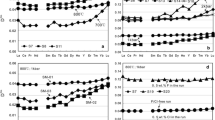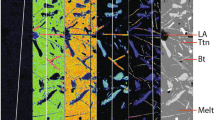Abstract
Here we present an experimental study of the distribution of a broad range of trace elements between carbonatite melt, calcite and fluorite. The experiments were performed in the CaCO3 + CaF2 + Na2CO3 ± Ca3(PO4)2 synthetic system at 650–900 °C and 100 MPa using rapid-quench cold-seal pressure vessels. Starting mixtures were composed of reagent-grade oxides, carbonates, Ca3(PO4)2 and CaF2 doped with 1 wt% REE–HFSE mixture. The results show that the distribution coefficients of all the analyzed trace elements for calcite and fluorite are below 1, with the highest values observed for Sr (0.48–0.8 for calcite and 0.14–0.3 for fluorite) and Y (0.18–0.3). The partition coefficients of REE gradually increase with increasing atomic number from La to Lu. The solubility of Zr, Hf, Nb and Ta in the synthetic F-rich carbonatitic melts, which were used in our experiments, is low and limited by crystallization of baddeleyite and Nb-bearing perovskite.




Similar content being viewed by others
References
Blundy J, Dalton J (2000) Experimental comparison of trace element partitioning between clinopyroxene and melt in carbonate and silicate systems, and implications for mantle metasomatism. Contrib Mineral Petrol 139:356–371
Brey GP, Bulatov VK, Girnis AV, Lahaye Y (2008) Experimental melting of carbonated peridotite at 6–10 GPa. J Petrol 49:797–821
Brey GP, Bulatov VK, Girnis AV (2011) Melting of K-rich carbonated peridotite at 6–10 GPa and the stability of K-phases in the upper mantle. Chem Geol 281:333–342. https://doi.org/10.1016/j.chemgeo.2010.12.019
Broom-Fendley S, Brady AE, Wall F, Gunn G, Dawes W (2017) REE minerals at the Songwe Hill carbonatite, Malawi: HREE-enrichment in late-stage apatite. Ore Geol Rev 81:23–41
Chakhmouradian AR, Reguir EP, Couëslan C et al (2016) Calcite and dolomite in intrusive carbonatites. II. Trace-element variations. Minerol Petrol 110:361–377. https://doi.org/10.1007/s00710-015-0392-4
Dalton JA, Presnall DC (1998a) Carbonatitic melts along the solidus of model lherzolite in the system CaO–MgO–Al2O3–SiO2–CO2 from 3 to 7 GPa. Contrib Minerol Petrol 131:123–135
Dalton JA, Presnall DC (1998b) The continuum of primary carbonatitic-kimberlitic melt compositions in equilibrium with lherzolite: data from the system CaO–MgO–Al2O3–SiO2–CO2 at 6 GPa. J Petrol 39:1953–1964
Dasgupta R, Hirschmann MM (2006) Melting in the Earth’s deep upper mantle caused by carbon dioxide. Nature 440:659–662
Dasgupta R, Hirschmann MM (2007) Effect of variable carbonate concentration on the solidus of mantle peridotite. Am Minerol 92:370–379
Dasgupta R, Hirschmann MM, McDonough WF, Spiegelman M, Withers AC (2009) Trace element partitioning between garnet lherzolite and carbonatite at 6.6 and 8.6 GPa with applications to the geochemistry of the mantle and of mantle-derived melts. Chem Geol 262:57–77
Doroshkevich AG, Veksler I, Klemd R, Khromova EA, Izbrodin IA (2017) Trace-element composition of minerals and rocks in the Belaya Zima carbonatite complex (Russia): implications for the mechanisms of magma evolution and carbonatite formation. Lithos 284–285:91–108. https://doi.org/10.1016/j.lithos.2017.04.003
Eggler DH (1978) The effect of CO<2) upon partial melting of peridotite in the system Na<2) O-CaO-Al<2) O<3) -MgO-SiO<2) -CO<2) to 35 kb, with an analysis of melting in a peridotite-H<2) O-CO<2) system. Am J Sci 278(3):305–343
Falloon TJ, Green DH (1989) The solidus of carbonated, fertile peridotite. Earth Planet Sci Lett 94:364–370
Falloon TJ, Green DH (1990) The solidus of carbonated fertile peridotite under fluid-saturated conditions. Geology 18:195–199
Foley SF, Yaxley GM, Rosenthal A, Buhre S, Kiseeva ES, Rapp RP, Jacob DE (2009) The composition of near-solidus melts of peridotite in the presence of CO2 and H2O between 40 and 60 kbar. Lithos 112:274–283
Gaetani GA, Kent AJR, Grove TL, Hutcheon ID, Stolper EM (2003) Mineral/melt partitioning of trace elements during hydrous peridotite partial melting. Contrib Minerol Petrol 145:391–405
Girnis AV, Bulatov VK, Brey GP, Gerdes A, Höfer HE (2013) Trace element partitioning between mantle minerals and silico-carbonate melts at 6–12 GPa and applications to mantle metasomatism and kimberlite genesis. Lithos 160–161:183–200
Green TH (1994) Experimental studies of trace-element partitioning applicable to igneous petrogenesis m Sedona 16 years later. Chem Geol 117:1–36
Green TH, Adam J, Sie SH (1992) Trace element partitioning between silicate minerals and carbonatite at 25 kbar and application to mantle metasomatism. Mineral Petrol 46:179–184
Gudfinnsson GH, Presnall DC (2005) Continuous gradation among primary carbonatitic, kimberlitic, melilititic, basaltic, picritic, and komatiitic melts in equilibrium with garnet lherzolite at 3–8 GPa. J Petrol 46:1645–1659
Hammouda T, Moine BN, Devidal JL, Vincent C (2009) Trace element partitioning during partial melting of carbonated eclogites. Phys Earth Planet Inter 174:60–69
Hammouda T, Chantel J, Devidal JL (2010) Apatite solubility in carbonatitic liquids and trace element partitioning between apatite and carbonatite at high pressure. Geochim Cosmochim Acta 74:7220–7235
Jago BC, Gittins J (1993) Pyrochlore crystallization in carbonatites: the role of fluorine. S Afr J Geol 96:149–159
Kjarsgaard BA, Hamilton DL (1989) The genesis of carbonatites by immiscibility. In: Bell K (ed) Carbonatites: genesis and evolution. Unwin Hyman, London, Boston, pp 388–404
Klemme S, van der Laan SR, Foley SF, Günther D (1995) Experimentally determined trace and minor element partitioning between clinopyroxene and carbonatite melt under upper mantle conditions. Earth Planet Sci Lett 133:439–448
Le Maitre RW (2002) Igneous rocks: a classification and glossary of terms. Cambridge University Press, Cambridge
Lee W, Wyllie PJ (1994) Experimental data bearing on liquid immiscibility, crystal fractionation and the origin of calciocarbonatites and natrocarbonatites. Int Geol Rev 36:797–819
Mariano AN (1989) Nature of economic mineralization in carbonatites and related rocks. In: Bell K (ed) Carbonatites: genesis and evolution. Unwin-Hyman, London, pp 149–176
Martin LHJ, Schmidt MW, Hannes B, Mattsson HB, Ulmer P, Hametner K, Günther D (2012) Element partitioning between immiscible carbonatite–kamafugite melts with application to the Italian ultrapotassic suite. Chem Geol 320–321:96–112
Martin LHJ, Schmidt MW, Mattson HB, Guenther D (2013) Element partitioning between immiscible carbonatite and silicate melts from dry and H2O-bearing systems at 1–3 GPa. J Petrol 54:2301–2338
Matthews W, Linnen RL, Guo Q (2003) A filler-rod technique for controlling redox conditions in cold-seal pressure vessels. Am Mineral 88:701–707
Mitchell RH (1997) Preliminary studies of the solubility and stability of perovskite group compounds in the synthetic carbonatite system calcite–portlandite. J Afr Earth Sci 25:147–158
Mitchell RH (2005) Carbonatites and carbonatites and carbonatites. Can Mineral 43:2049–2068
Mitchell RH, Kjarsgaard BA (2002) Solubility of niobium in the system CaCO3–Ca(OH)2–NaNbO3 at 0.1 GPa pressure. Contrib Mineral Petrol 144:93–97. https://doi.org/10.1007/s00410-002-0384-3
Mitchell RH, Kjarsgaard BA (2004) Solubility of niobium in the system CaCO3–CaF2–NaNbO3 at 0.1 GPa pressure: implications for the crystallization of pyrochlore from carbonatite magma. Contrib Mineral Petrol 148:281–287. https://doi.org/10.1007/s00410-004-0603-1
Otto JW, Wyllie PJ (1993) Relationship between silicate melts and carbonate-precipitating melts in CaO–MgO–SiO2–CO2–H2O at 2 kbar. Mineral Petrol 48:343–365
Paton C, Hellstrom J, Paul B, Woodhead J, Hergt J (2011) Iolite: freeware for the visualisation and processing of mass spectrometric data. J Anal At Spectrom. https://doi.org/10.1039/c1ja10172b
Prowatke S, Klemme S (2006) Rare earth element partitioning between titanite and silicate melts: Henry’s law revisited. Geochim Cosmochim Acta 70:4997–5012
Ryabchikov ID, Orlova GP, Senin VG, Trubkin NV (1993) Partitioning of rare earth elements between phosphate-rich carbonatite melts and mantle peridotites. Mineral Petrol 49:1–12
Sun SS, McDonough WF (1989) Chemical and isotopic systematics of oceanic basalts; implications for mantle composition and processes. In: Saunders AD, Norry MJ (eds) Magmatism in the ocean basins, vol 42. Geological Society of London, London, pp 313–345
Sweeney RJ (1994) Carbonatite melt compositions in the Earth’s mantle. Earth Planet Sci Lett 128:259–270
Sweeney RJ, Prozesky V, Przybylowicz W (1995) Selected trace and minor element partitioning between peridotite minerals and carbonatite melts at 18–46 kbar pressure. Geochim Cosmochim Acta 59:3671–3683
Tomkute V, Solheim A, Sakirzanovas S, Oye B, Olsent E (2014) Phase equilibria evaluation for CO2 capture: CaO–CaF2–NaF, CaCO3–NaF–CaF2, and Na2CO3–CaF2–NaF. J Chem Eng Data 59:1257–1263
Veksler IV, Nielsen TFD, Sokolov SV (1998a) Mineralogy of crystallized melt inclusions from Gardiner and Kovdor ultramafic alkaline complexes: implications for carbonatite genesis. J Petrol 39:2015e2031
Veksler IV, Petibon C, Jenner G, Dorfman AM, Dingwell DB (1998b) Trace element partitioning in immiscible silicate and carbonate liquid systems: an initial experimental study using a centrifuge autoclave. J Petrol 39:2095–2104
Veksler IV, Dorfman AM, Dulski P, Kamenetsky VS, Danyushevsky LV, Jeffries T, Dingwell DB (2012) Partitioning of elements between silicate melt and immiscible fluoride, chloride, carbonate, phosphate and sulfate melts with implications to the origin of natrocarbonatite. Geochim Cosmochim Acta 79:20–40
Wallace ME, Green DH (1988) An experimental determination of primary carbonatite magma composition. Nature 335:343–346
Woodhead J, Hellstrom J, Hergt J, Greig A, Maas R (2007) Isotopic and elemental imaging of geological materials by laser ablation Inductively coupled plasma mass spectrometry. J Geostand Geoanal Res 31:331–343
Woolley AR, Kjarsgaard BA (2008) Carbonatite occurrences of the world: map and database. Geological Survey of Canada. 28 pages (1 sheet); 1 CD-ROM. https://doi.org/10.4095/225115
Wyllie PJ, Huang WL (1976) Carbonation and melting reactions in the system CaO–MgO–SiO2–CO2 at mantle pressures with geophysical and petrological applitations. Contrib Mineral Petrol 54:79–107
Xie Y, Hou Z, Yin S, Dominy SC, Xu J, Tian S, Xu W (2009) Continuous carbonatitic melt-liquid evolution for REE mineralization system: evidence from inclusions in the Maoniuping REE deposit in the western Sichuan, China. Ore Geol Rev 36:89–104
Xie Y, Li Y, Hou Z, Cook DR, Danyushevsky L, Dominy SC, Yin S (2015) A model for carbonatite hosted REE mineralisation—the Mianning–Dechang REE belt, western Sichuan Province, China. Ore Geol Rev 70:595–612
Acknowledgements
We thank Christian Schmidt, Hans-Peter Nabein, Reiner Schulz, Anton F. Shatsky, Konstantin D. Litasov, Galina I. Galay, Oona Appelt, Schäpan, Hau Hu for their help and consultations during preparation of the article. Reviews by Roberth Luth and Ramya Murali helped to significantly improve the text. The work is done on state assignment of IGM SB RAS.
Author information
Authors and Affiliations
Corresponding author
Additional information
Communicated by Timothy L. Grove.
Rights and permissions
About this article
Cite this article
Chebotarev, D.A., Veksler, I.V., Wohlgemuth-Ueberwasser, C. et al. Experimental study of trace element distribution between calcite, fluorite and carbonatitic melt in the system CaCO3 + CaF2 + Na2CO3 ± Ca3(PO4)2 at 100 MPa. Contrib Mineral Petrol 174, 4 (2019). https://doi.org/10.1007/s00410-018-1530-x
Received:
Accepted:
Published:
DOI: https://doi.org/10.1007/s00410-018-1530-x




